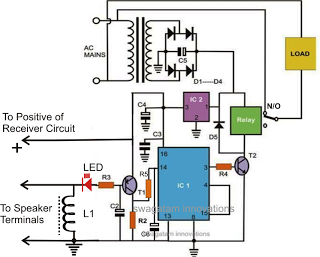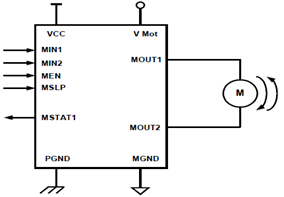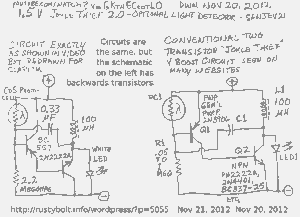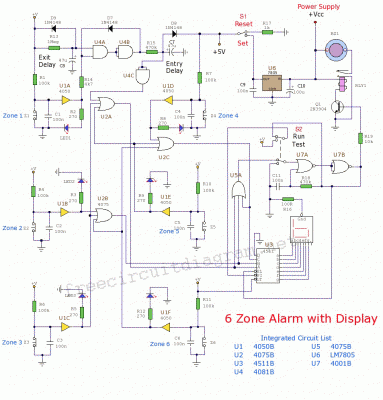
how to make remote control circuit from

The proposed remote control circuit can be utilized to control any electrical device within a range of 100 meters. This concept involves modifying an existing remote bell unit circuit, making the process straightforward. However, the construction aspect necessitates electronic assembly skills, which may render this project unsuitable for complete beginners. Remote bell gadgets, commonly found in households, consist of a wireless RF receiver and transmitter set designed to produce alarm sounds for calling or indication purposes. The receiver unit, positioned within the specified range, activates the built-in musical bell, sounding the alarm. The trigger may persist for a short duration even after the transmitter is turned off. By modifying the receiver component to operate a relay instead of the standard alarm, the project objectives can be achieved. Before proceeding with the modification, it is essential to create a flip-flop circuit, which will later be integrated with the remote bell receiver. The flip-flop section is a simple configuration involving a single IC and a few passive components. The entire circuit can be constructed on a small general-purpose board, as illustrated in the schematic. A small speaker connected with wires from the unit's circuit board should be disconnected, and the circuit removed from its original housing. It should then be placed inside a new, larger housing to accommodate the flip-flop circuit, transformer power supply, and relay assembly. The RF remote control circuit will then be ready for wireless operation of any chosen electrical device within a radius of approximately 100 meters.
The remote control circuit is designed to utilize a radio frequency (RF) communication system, which allows for wireless control of devices over a considerable distance. The core components of this circuit include a transmitter, a receiver, a flip-flop circuit, and a relay. The transmitter sends RF signals when activated, while the receiver picks up these signals and triggers the connected components.
The flip-flop circuit serves as a memory element, maintaining the state of the relay even when the transmitter is turned off. This is crucial for applications where the controlled device needs to remain activated without continuous input from the transmitter. The flip-flop can be built using a popular IC such as the 555 timer configured in bistable mode, which can be easily integrated with the receiver's output.
The relay acts as a switch that can handle the voltage and current requirements of the electrical gadgets being controlled. It is essential to select a relay with appropriate ratings to ensure safe operation. The power supply for the circuit can be derived from a standard transformer, which steps down the mains voltage to a suitable level for the circuit components.
The assembly of the circuit should be done with care, ensuring all connections are secure and properly insulated. The new housing should be designed to provide adequate space for all components, along with ventilation to prevent overheating. Once assembled, the circuit can be tested within the specified range to ensure reliable operation.
In summary, this remote control circuit provides a practical solution for wireless control of electrical devices, leveraging existing technology in a modified form. With careful construction and assembly, it offers an effective means to enhance everyday convenience in home automation.The proposed remote control circuit idea can be used for controlling any electrical gadget within a range of 100 meters. Since the idea here is to modify an existing circuit of a remote bell unit, becomes super easy without any complications.
However the construction part does require the involvement of electronic assemblies so this project ma y not be considered entirely a layman`s project. We all have seen and probably used remote bell gadget in our homes. The device is basically a wireless RF receiver and a transmitter set which can be used for producing alarm sounds remotely for calling or indication proposes. The receiver unit positioned anywhere within this limit instantly plucks the trigger and switches the in built musical bell, sounding the alarm.
The trigger may last for a few moments even after the transmitter is switched OFF. If we are able to mod the receiver part of the unit so that the received trigger can be used to operate a relay instead of the usual alarm, our job is done. However before we indulge into the modification process, it would be necessary to make the Flip Flop circuit first, which would be later on required to be integrated with the receiver set of the remote bell.
The flip flop section is a very simple configuration consisting of just a single IC and a few other passive components. The entire circuit may be buikt over a small general purpose board with the help of the shown schematic.
You will find a small speaker connected via a couple of wires which terminate from the circuit board of the unit. Just cut-of the wires from the speaker, remove the entire circuit from its housing and screw it inside a new housing, which should be relatively bigger in size so that it can accommodate the flip flop section, the transformer power supply section and also the relay assembly.
Your RF remote control circuit is ready and may be used for controlling any electrical gadget that you may prefer, wirelessly, across a radial distance of around 100 meters. 🔗 External reference
The remote control circuit is designed to utilize a radio frequency (RF) communication system, which allows for wireless control of devices over a considerable distance. The core components of this circuit include a transmitter, a receiver, a flip-flop circuit, and a relay. The transmitter sends RF signals when activated, while the receiver picks up these signals and triggers the connected components.
The flip-flop circuit serves as a memory element, maintaining the state of the relay even when the transmitter is turned off. This is crucial for applications where the controlled device needs to remain activated without continuous input from the transmitter. The flip-flop can be built using a popular IC such as the 555 timer configured in bistable mode, which can be easily integrated with the receiver's output.
The relay acts as a switch that can handle the voltage and current requirements of the electrical gadgets being controlled. It is essential to select a relay with appropriate ratings to ensure safe operation. The power supply for the circuit can be derived from a standard transformer, which steps down the mains voltage to a suitable level for the circuit components.
The assembly of the circuit should be done with care, ensuring all connections are secure and properly insulated. The new housing should be designed to provide adequate space for all components, along with ventilation to prevent overheating. Once assembled, the circuit can be tested within the specified range to ensure reliable operation.
In summary, this remote control circuit provides a practical solution for wireless control of electrical devices, leveraging existing technology in a modified form. With careful construction and assembly, it offers an effective means to enhance everyday convenience in home automation.The proposed remote control circuit idea can be used for controlling any electrical gadget within a range of 100 meters. Since the idea here is to modify an existing circuit of a remote bell unit, becomes super easy without any complications.
However the construction part does require the involvement of electronic assemblies so this project ma y not be considered entirely a layman`s project. We all have seen and probably used remote bell gadget in our homes. The device is basically a wireless RF receiver and a transmitter set which can be used for producing alarm sounds remotely for calling or indication proposes. The receiver unit positioned anywhere within this limit instantly plucks the trigger and switches the in built musical bell, sounding the alarm.
The trigger may last for a few moments even after the transmitter is switched OFF. If we are able to mod the receiver part of the unit so that the received trigger can be used to operate a relay instead of the usual alarm, our job is done. However before we indulge into the modification process, it would be necessary to make the Flip Flop circuit first, which would be later on required to be integrated with the receiver set of the remote bell.
The flip flop section is a very simple configuration consisting of just a single IC and a few other passive components. The entire circuit may be buikt over a small general purpose board with the help of the shown schematic.
You will find a small speaker connected via a couple of wires which terminate from the circuit board of the unit. Just cut-of the wires from the speaker, remove the entire circuit from its housing and screw it inside a new housing, which should be relatively bigger in size so that it can accommodate the flip flop section, the transformer power supply section and also the relay assembly.
Your RF remote control circuit is ready and may be used for controlling any electrical gadget that you may prefer, wirelessly, across a radial distance of around 100 meters. 🔗 External reference





